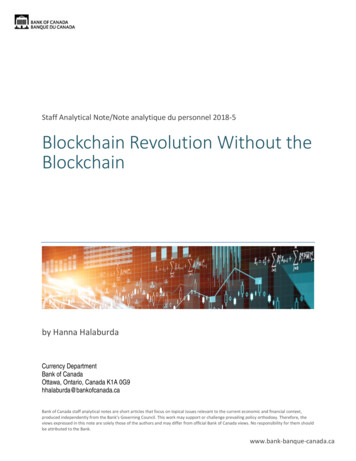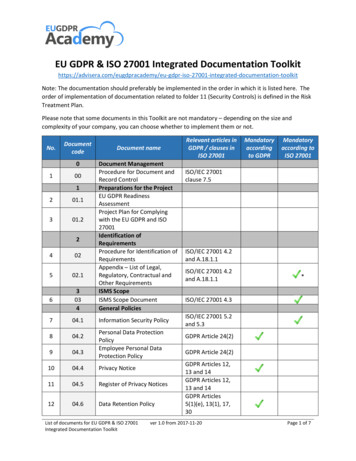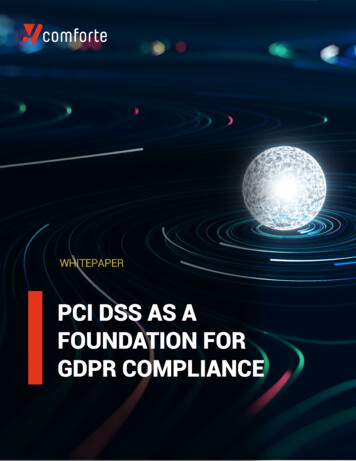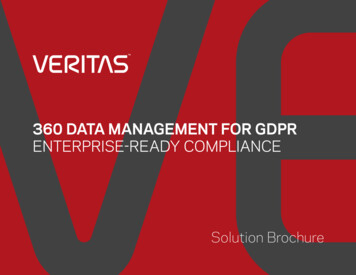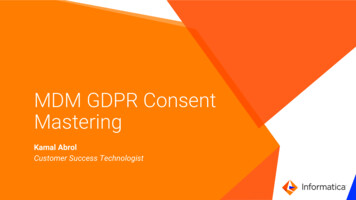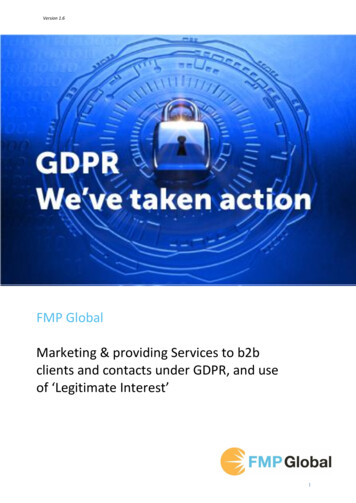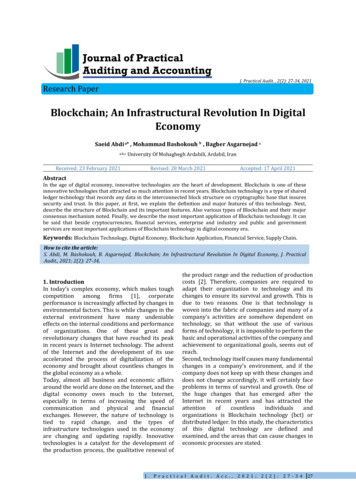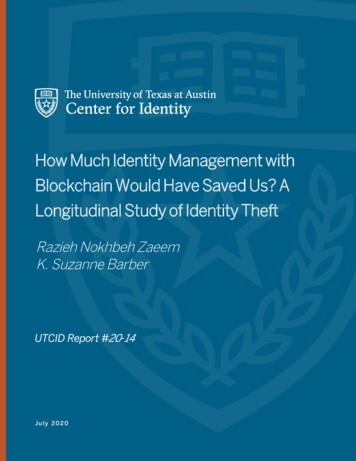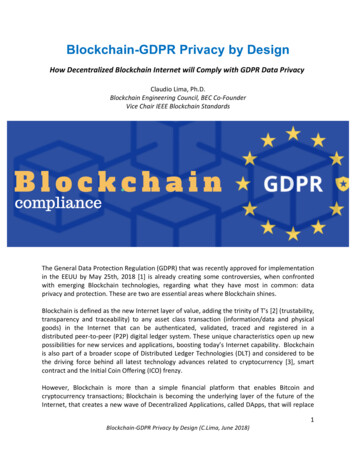
Transcription
Blockchain-GDPR Privacy by DesignHow Decentralized Blockchain Internet will Comply with GDPR Data PrivacyClaudio Lima, Ph.D.Blockchain Engineering Council, BEC Co-FounderVice Chair IEEE Blockchain StandardsThe General Data Protection Regulation (GDPR) that was recently approved for implementationin the EEUU by May 25th, 2018 [1] is already creating some controversies, when confrontedwith emerging Blockchain technologies, regarding what they have most in common: dataprivacy and protection. These are two are essential areas where Blockchain shines.Blockchain is defined as the new Internet layer of value, adding the trinity of T’s [2] (trustability,transparency and traceability) to any asset class transaction (information/data and physicalgoods) in the Internet that can be authenticated, validated, traced and registered in adistributed peer-to-peer (P2P) digital ledger system. These unique characteristics open up newpossibilities for new services and applications, boosting today’s Internet capability. Blockchainis also part of a broader scope of Distributed Ledger Technologies (DLT) and considered to bethe driving force behind all latest technology advances related to cryptocurrency [3], smartcontract and the Initial Coin Offering (ICO) frenzy.However, Blockchain is more than a simple financial platform that enables Bitcoin andcryptocurrency transactions; Blockchain is becoming the underlying layer of the future of theInternet, that creates a new wave of Decentralized Applications, called DApps, that will replaceBlockchain-GDPR Privacy by Design (C.Lima, June 2018)1
most of today’s centralized cloud Internet application. With Blockchain, businesses willexperience a complete transformation of their current models by removing intermediaries,reducing costs and improving the trustability of the Internet, and therefore enabling a newwave of decentralized services.At the time, the GDPR was first proposed by the European Union in 2012 [4], the Internet wasonly focused around the web-centric centralized cloud-based Internet. All GDPR data collectionand processing for companies and individuals were considered based solely on this centralizedcloud service model world. With the full introduction of P2P decentralized Internettechnologies concepts around July 2017, which is the foundation of DLT/Blockchain, the GDPRmodel as it has been conceived is already outdated.The first consequence of this assumption is that the enforcement of GDPR becomes a verychallenging and controversial subject. From the lawmakers and regulators perspective, itrequires adjustments to the GDPR framework to adapt to the new Blockchain-drivendecentralized Internet technology model. In some cases, this could even threaten the broadadoption of decentralized Blockchain models if this issue is not well understood and clarified atthe beginning since Blockchain and GDPR are recent trends and the market still thinks thatBlockchain is only Bitcoin and cryptocurrency and not the enabler of the next generationInternet of value layer.These GDPR new rules grant more rights to the consumer data-owner. Fortune’s Global 500companies will spend 7.8 billion to ensure they are compliant with GDPR [5] and meet thisnew consumer data ownership rules. The EU GDPR establishes directives on how companiescan handle Personal Identification Information (PII), which can be considered as any data thatcan be used to identify a specific individual such as mailing and email address, phone number,social security number, driver license and so one. It can also consider user’s computer IPaddress, login IDs, digital images, geolocation, social media posts, digital images and behavioraldata as well. GDPR non-compliance can result in fines of up to 4 percent of a company’s yearlyrevenue or 24 million dollars (whatever amount is more significant).Particularly, Blockchain personal ID management and processes, such as KYC - Know YourCustomers and others that store and process PII are critical to the design of GDPR compliantBlockchain solutions. The main challenges are related to public permissionless Blockchaintechnologies where, due how the blocks and Blockchain transactions are built, all informationand records that enter the distributed ledgers, which are the main components of Blockchain,are publically visible, tamper-proof and immutable, which means that the data added to thepublic permissionless Blockchain is there forever as they are copied to any single distributedBlockchain P2P nodes, usually called “miner”, working as a large distributed database.However, the immutability of data transactions that are imprinted in the fabric of thesedistributed ledgers implies that one of the key principles of GDPR, Art. 17 Right to erasure(“Right to be Forgotten”), is not met by Blockchain. This principle applies when a consumerBlockchain-GDPR Privacy by Design (C.Lima, June 2018)2
requests the data provider, called the “controller”, to erase their personal information and dueto this immutability characteristics, the data cannot be removed.However, to understand the mechanism how Blockchain works and how the data is stored inthe Blockchain layer, it is necessary to introduce another two new Blockchain concepts whichare cryptography and hashing. In Blockchain world all information is encrypted and hashedusing specific algorithms and functions and then stored in the Blockchain distributed ledgers.Hashing is a one-way transformation of any input data to an unreadable 64 characters (SHA-256hash algorithm) long sequence of fixed length, called hashed data [6]. Therefore, technicallyspeaking, the consumer personal data and information, or other metadata, when stored in theBlockchain itself cannot be modified due the principle on how Blockchain works, as explainedbefore.However, there are alternative solutions for this challenge, which is the adoption of off-chaindata storage architectures where all GDPR sensitive information and data are stored off-chainin distributed or cloud-based servers and the hashes, which is a specific encryption of this data(the reference or linkage to this data), are stored in the Blockchain layer, which serves ascontrol pointers to these data stored off-chain. These control pointers are not the real datathemselves but a pseudonymization of the original data that is stored elsewhere in anotherdatabase which is not subject to the issues regarding record immutability that Blockchainprovides. Analyzing the particular case of GDPR Art. 17 “Right to be Forgotten”; when theconsumer requests, the service provider can then erase the “linkability” of the Blockchain hashpointer to the data located in distributed off-chain servers and this solution should work for thepurpose.In particular, GDPR Art.25 “Data Protection by Design and By Default" is the most interestingand maybe the most controversial article related to Blockchain, since anonymization techniquesare also addressed by the GDPR. In Blockchain, the pseudoanonymization technique consideredis hashing, as discussed above. However, there two interpretations for the pseudoanonymlinkage using Blockchain - where the user’s data creates the hash of this data. The firstassumption is that when this linkage is established, it is no longer considered personal sincedata pseudonymisation is accomplished, but not anonymization. On the other hand, there maybe still need some proof or mathematical validation, based on GDPR Art.25, that off-chain datalinkage using hashing might have some small possibility of being compromised by brute forceattack. Besides, there are other hashing and consensus algorithm techniques that are not evenconsidered here, like the ones that allow the owner of smart contract transaction to validate itwithout revealing their personal data. The conclusion that all this points out is that this issue isa moving target as the introduction of Blockchain innovation is speeding up, and a legaltechnical battle lies aheadAnother challenge not yet completely addressed for the GDPR-Blockchain compliance is thatdue to the decentralized ownership model of the Blockchain technology, the data processors(data controller) cannot be held legally accountable as they are not clearly defined or specifiedBlockchain-GDPR Privacy by Design (C.Lima, June 2018)3
since all ownership is decentralized.A further improvement of this off-chain Blockchain-GDPR compliance architecture is tocombine public Blockchain with trusted computing enclaves to enhance privacy and securitylevels of the Blockchain network. These enclaves are new hardware-coded trusted nodes thatenable an extra layer of security and efficiency for off-chain transactions.Personal information and identification (PII) are just one subset of what can be stored in theBlockchain. Other data types such as the public encrypted key and other types of hashed andencrypted data that points to some particular and specialized set of data, such as P2P networkand nodes machine state ID and performance, consumer indexes and so one, can also beconsidered. Figure 1 shows this GDPR-Blockchain compliance architecture described above.Fig.1 - GDPR-Blockchain Compliant ArchitectureThere are other variants of Blockchain, called Enterprise Blockchain, that is not affected asmuch as the public Blockchain types are. This type of private Blockchain can easily comply withBlockchain-GDPR Privacy by Design (C.Lima, June 2018)4
GDPR directives since the transactions of the digital records of the stored information can bemodified and erased by the private entities or authorities who can own and control thisplatform, using a particular class of consensus algorithm, that can handle this data accessibility,since this is a permissioned Blockchain solution.In summary, most of the initial reaction regarding Blockchain is that this new technology is notcompatible at all with the new GDPR directives. However, as it was explained here, this is asuperficial assumption and conclusion to make without exploring other possibilities andclarifying how Blockchain in fact works and understanding its key underlying concepts andtechnologies. Indeed, Blockchain can be considered a technology that can not only improve thefundamental aspect of data privacy and security, as specified in GDPR, compared to thetraditional centralized Internet approach, but can also be carefully studied, architected andimplemented with a GDPR-compliance intent for data privacy, using some unique techniques.These alternatives are not simple to implement, and they require a deep understanding on howBlockchain/DLT works and how the technology ecosystem is interrelated, to create GDPRBlockchain compatible architectures.All the points addressed here are topics currently being debated in the industry as BlockchainGDPR is still in the early stages of paving the way for a complete GDPR-Blockchain compliance.Even if there are technology alternatives to create GDPR compliant Blockchain systems, thedebate and controversy are still alive, and the main conclusion points out for the revision of thisrecently introduced GDPR framework to consider the new decentralized Internet models andhash-based Blockchain technologies.[1] General Data Protection Regulation (GDPR, https://gdpr-info.eu, May 2016.[2] C. Lima, "Blockchain Is the New Internet - The Trinity of Ts”, https://goo.gl/hq7ACy, Jan 2018.[3] Satoshi Nakamoto. "Bitcoin: A Peer-to-Peer Electronic Cash System”, bitcoin.org, 2009.[4] Survey Fortune 500 Companies, https://goo.gl/Hqw94H[5] The History of General Data Protection Regulation, https://goo.gl/fCWw5u[6] Secure Hash Algorithm (SHA-256), https://en.wikipedia.org/wiki/SHA-2Author: Claudio Lima, Ph.D.Blockchain Engineering Council, BEC, Co-FounderIEEE Blockchain Standards, Co-Chairclima@blockchain-eng.orgBlockchain-GDPR Privacy by Design (C.Lima, June 2018)5
contract and the Initial Coin Offering (ICO) frenzy. However, Blockchain is more than a simple financial platform that enables Bitcoin and cryptocurrency transactions; Blockchain is becoming the underlying layer of the future of the Internet, that creates a new wave of Decentralized Applications, called DApps, that will replace

